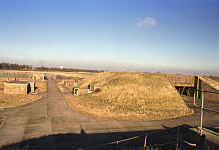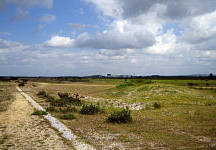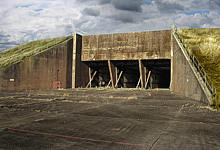
The Greater London Council
Maygrove Park Gallery
Burgess Park Gallery
Tavistock Square Gallery
Noel-Baker Gardens:
Noel-Baker Gardens Gallery
Opening Day Programme
Other Sites:
Greenham Common
Greenham Common Gallery
Castle Park Bristol
Castle Park Gallery
A Brief Topographical History Protest and Peace A Peace Garden



A Brief Topographical History
Less than one mile from the historic town of Newbury in Berkshire, and some twenty miles west of central London, Greenham Common is a thousand acre tract of mostly level common land that has occupied since the Neolithic period – hand hewn axe heads have been found, as have pottery fragments from the Romano-British period. A church at Greenham is mentioned in the Domesday Book, and in 1199 the Manor at Greenham was granted by King John to the Knights Hospitallers, who remained until the middle of the 16th century. The Common has long been used by the military: Parliamentary troops gathered on there in 1643, and one hundred years later it was used as a marshalling base for English troops during the Jacobite Rebellion. The open, flat land of the Common made it useful for troop maneouvres again in 1862 and 1890.
Although largely untouched by landscape designers, the fish ponds at the western end of the Common – on Sandleford Heath – were re-modelled by landscape designer “Capability” Brown in 1781.
As a tract of open land close to a thriving market town, the Common was a popular venue for walkers, cyclists and picnic parties in the first half of the 20th century. However, in 1941 much of the land was requisitioned for military use, and rapidly transformed into an airbase, initially for use by the Royal Air Force (RAF) but from the summer of 1942 by the US Army Air Force, who used it as one of the bases for the invasion of France in 1944. It was at Greenham that General Dwight D. Eisenhower made his famous 'Eyes of the world' speech, and was photographed talking to camouflaged paratroopers waiting to board C-47 'Skytrains' on 5th June 1944, the eve of the Allied landings in Normandy.
After the American forces transferred their command to France the military base reverted to RAF control and was effectively ‘stood down’ in 1946. Briefly the Common reverted to its past use as land free to all, although much of the terrain was littered with former military buildings and other paraphernalia.
However, in 1951 as the Cold War began, the site was re-activated as a US Strategic Air Command Base (SAC) coming under US Air Force operational control in June 1953. A 9,000 feet long runway was constructed, with two 1,000 feet ’overshoots’ added in 1958. A new munitions area was constructed to the south-west of the site, and eight I million gallon underground fuel tanks were also dug. Strategic Air Command left Greenham Common in 1964, but the site saw occasional use during NATO exercises, and for a short while became the home of the International Air Tattoo. A proposal by the USAF in 1977 - to house aerial refueling tankers on the base - was vetoed by the British government following widespread local opposition.
In 1979, in response to the Soviet proliferation of nuclear forces, NATO approved plans to situate some 600 nuclear cruise missiles in Western Europe. In 1980 the British government announced the deployment of 96 Tomahawk ground launched cruise missiles at Greenham Common; these would be under the control of the 501st tactical missile unit USAF. Six large missile shelters were specially constructed to house the missiles; the first to be based on British soil. It was intended that the base would be operational by December 1983, the missiles arriving on November 13th 1983. The six shelters were constructed to protect the missiles from nuclear and conventional attack. Standing some 10 metres high, each shelter has a reinforced concrete ceiling about two metres thick, below a steel plate, around three metres of sand, a further reinforced concrete slab, all covered with tonnes of soil. Each had six bombproof steel doors, three at each end. It is reckoned that each shelter was designed to withstand a thermonuclear airburst explosion above Greenham Common and Newbury or a direct hit from a 500lb conventional bomb.
The militarized zone was known by the acronym of GAMA (GLCM Alert and Maintenance Area) and covered some 74 acres, the bunkers were located to the south of the 850 acres of the entire Greenham Common area; the runway itself was the longest in Europe.
Protest and Peace
In September 1981 a group in Cardiff opposed to nuclear power and nuclear weapons set out to protest at NATO’s decision to site missiles in Britain. Thirty six individuals, under the all-embracing banner ‘Women for Life on Earth’, walked 120 miles to Greenham Common. Attracting little attention from the media en route they decided to chain themselves to the perimeter fence of the airbase and establish a ‘permanent’ peace camp – initially at the main entrance known as ‘Yellow Gate’ - from where they could espouse their arguments. .
Over the two decades of occupation the ‘camp’ came to consist of nine smaller camps::
-
the first was Yellow Gate, established the month after
Women for Peace on Earth reached the airbase;
others established in 1983 were Green Gate, the nearest to the silos, and the only entirely exclusive
women - only camp at all times, the others accepting male visitors during the day; Turquoise Gate;
Blue Gate with its new age focus; Pedestrian Gate; Indigo Gate; Violet Gate identified as being religiously
focused; Red Gate known as the artists gate; and Orange Gate.
Reference code(s): GB 0106 5/GCC, Held at: Women's Library: The Greenham Common Collection, 1982-1983
On the eve of the Falklands War in 1982, 250 women attempted the first blockade of the base, leading to 34 arrests. Two months later, in May 1982, bailiffs and police attempted to clear the women and their possessions from the site. This was the first attempt to evict the peace camp. The women responded by re-locating their tents, ‘benders’, and other temporary cover nearby. A programme of minor incursions and protests followed:
-
The women would stage "actions" or acts of
protest, which ranged from laying down in front of lorries and threading
paper peace doves and baby clothes into the perimeter fence, to cutting
through the fence with bolt croppers, exercising what they stated was
their right to walk on common land. news.bbc.co.uk/1/hi/special_report/1999/11/99/greenham_common/
After 44 women were arrested for dancing atop the missile silos on New Years Day 1983, a further mass demonstration followed in April of that year, when CND supporters mobilised 70,000 people in a 14-mile long human chain that linked Burghfield, Aldermaston and Greenham – key sites on the ‘nuclear valley’. ’. news.bbc.co.uk/onthisday/hi/dates/stories/april/1/newsid_2520000/2520753.stm
Such mass protest, met by a massive police and military response, could not prevent the first transfer of cruise missiles to the airbase in November 1983. One month later, another mass gathering – of some 50,000 women – resulted in mass arrests after protesters dismantled sections of fencing and trespassed onto the GAMA.
This protest gave rise to one of the most significant visual images of the long campaign – the web. Webs of coloured wool had been created by individuals and scattered throughout the camps from the early days of occupancy: the web became a powerful metaphor for the strength of the women’s networks, stressing its interdependency and organic nature, its intricate tangle of connected causes. Its greatest visual impact occurred during the huge protest on 12th December 1983 when thousands of protesting women wove into the perimeter wire wool, ribbon, toys, flowers, photographs, and tokens of peace. The site became transformed by an extensive calligraphy of coloured patchwork, a powerful representation of the ‘private sphere of affection, stability and fertility’ which the protesters sought to maintain in the ‘face of possible annihilation.’ Marina Warner has captured the several levels of this intervention, ‘the intricate tangle of symbols had to be laboriously unpicked by the authorities, proving far more arduous to clear than the rubbish of placards left by a more usual march.’ Warner suggests that cutting loose the strands, unpicking the woven mementoes brought the police and the military authorities down to the women’s level, reduced to ‘fiddly task[s] of the kind women are traditionally required to do.’ (Marina Warner, Monuments and Maidens: the allegory of the human form, Virago: London 1985, pp.58-59)
During the nineteen years of protest and occupancy of the various sites, the campaign fragmented and occasionally degenerated into disputes over complex political issues. As one commentator noted:
-
Inevitably the sense of excitement at the camp could
not be sustained. The camp became an increasingly
bitter, internalised place to visit, where the lifestyle of the protest had become more important than the
cause itself. What had seemed like a short cut to effective action became a long road to disillusion for many.
Judy Cox, Greenham women: An uncommon struggle Issue 245 Socialist Review, October 2000
In September 1997 the common land at Greenham was returned to the people of Newbury at an estimated ‘clear-up’ cost of 7.5 million pounds. Two years later the remaining ‘residents’ of the last peace camp held a New Year’s Eve party in December 1999 before dismantling their camp and leaving.
One of the last to depart – ‘Joan’ – is reported to have said, 'I carry with me from Greenham a sense of the need to act and not just agree to things being done in my name without letting the government know that I oppose them.' (cited on Peace Pledge Union website, July 2005, www.ppu.org.uk/women/wo-update3.html)
Another woman, ‘Rebecca’, who had lived at the camp for five years, said: 'Greenham didn't transform just the lives of the women who lived there, but the lives of thousands of women all over the world'. (cited on Peace Pledge Union website, July 2005, www.ppu.org.uk/women/wo-update3.html)
A Peace Garden
By April 2000, when the perimeter fence was finally taken down, the air base buildings had mostly been removed or converted. A business park had been established on the southern edge, the airstrip had been dug over and heathland was being returned to plants and wild life. A Greenham Trust had been created, arts projects were being developed, and there was debate as to how to develop the site without ignoring its unique bio-diversity nor its recent political history.
Above all, there was a widespread concern that Greenham Common’s significance for the women's peace movement should not be forgotten. One woman is quoted as saying: 'The real memorial to Greenham is in the hearts and actions of the women who were there'.
(cited on Peace Pledge Union website, July 2005, www.ppu.org.uk/women/wo-update3.html)
The last remnant of the peace camps in the late 1990s was a single caravan, a lone mobile home parked irreverently at the entrance to the New Greenham Park industrial estate, a mixed collection of small businesses and larger companies some housed in former military buildings. The park is entered via a large roundabout, expertly landscaped, and fronted by a well designed gatehouse in a high-specification corporate finish. By contrast the caravan, like so many temporary structures that had circled the site was unkempt, colourful and strewn with banners and protest insignia. Occupied by three women in rotation they sought, and gained, planning permission to construct a memorial to the peace activities. Amongst talk of preserving the last ‘peace caravan’ at a proposed visitors centre, a number of landscaping options were raised – a waterpark, a peace garden, a lavender field, a ‘virtual reality nuclear wasteland’. These ideas emerged from a competition organized by the Greenham Common Trust during 1997-98 to find ideas for the future of the common. Judged by such eminent figures as Sir Norman Forster and Lord Lloyd-Webber (a Berkshire resident) the winning proposal, by architects Simon Loring and Mike Smith, was based on:
-
'(a) utopian view of the technology of the information age resolving the
issues of the nuclear age, so as not to inflict disasters on future generations…The
symbolic form of the Greenham Common must be retained.’
It was considered unlikely, however, that the winning design would ever be realised. Instead, the Trust used the ideas, designs and the accompanying debate as a way of generating debate about the future of the larger site, rather then focusing exclusively on the commemoration of the women’s camps. One contemporary review noted optimistically:
-
...at least the last peace caravan is going to be preserved
at the forthcoming visitors' centre, and a
monument to the camp has been proposed. Lynne Segal sees the camp as a symbol of a past era
of protest, while journalist Joan Smith applauds it as an enduring symbol of how ordinary people can
challenge the most powerful forces on earth.
Judy Cox, Greenham women: An uncommon struggle, issue 245 Socialist Review, October 2000.
The other feature is a stone and steel spiral form, which acts as a water fountain, its water flowing perpetually over carved words that spell out a defiant note:
-
"Women's Peace Camp 1981- 2000. You can't kill the Spirit."
This garden is the sole reminder of the women’s peace camps that so characterised the Common and its airbase for over nineteen years. There are few other markers. A few remnants of their occupancy at other sites can be found. For example, at what is left of Green Gate (the nearest to the missile silos) the metal pillars are still inscribed with painted snake-forms in green and pale blue. But this lack of visual or topographic tracery is typical of the womens’ wish not to permanently stain or mark the site of the long occupation. True to their broader politic principles, the Women’s groups grasped the rapport between eco-feminism and the feminist direct-action movement. (for an elaboration see Ynestra King, Prospects for a Contemporary Peace Movement: An Ecofeminist Perspective, Political Environments #2, Summer 1995).
The landscaping and planting of the garden was negotiated between the last occupants of the site and a landscape consultant. In common with other low maintenance sites it includes plants such as Snowdrops, Snowflakes, Autumn Crocus, Wild Daffodils and Lily of the Valley – ‘informal’ species that symbolize local values rather than more conventionally formal memorial flowers such as roses, which require continual constant maintenance and are more often associated with formal, civic or ‘official’ remembrance.
Sarah Hipperson, former Greenham peace protestor and co-ordinator for the Commemorative Fund Appeal, said of the finished garden: "This is a fitting tribute for a place that is acknowledged worldwide as a site of historical importance and a recognition of all those women who took part, however small, in the protests for peace at Greenham."
www.Greenham-common-trust.co.uk
The garden was formally opened in October 2002, following a much-needed donation towards the appeal of £10,000 from Yoko Ono, widow of the former Beatle John Lennon. The total cost of the garden was estimated at £50,000. At the inauguration, a message from Ms Ono was read out:
-
"To the sisters of the Peace Camp on Greenham Common, Congratulations!
I am there with you
in spirit. Love, Yoko."
-
“We are confronted once again by those who prefer
war and death than peace and cooperation,
health and education’. He concluded by stating that the “brave women of Greenham would be
remembered in the history of the world.”
(Newbury Weekly News, 18th October 2002. The same newspaper noted that the NUM had donated £5,000 towards the memorial and, in 1981, had supplied coal for the women’s campfires).
Tucked into one side of the garden, obvious only by a small plaque, is a plot dedicated to the memory of one Helen Wynne Thomas, a 22 year old Welsh woman, who was the only protester to die at Greenham Common. In the final days of the occupation – on 5th August 1989 - she was struck accidentally by a towed West Midlands Police horsebox as she stood on the safe zone waiting to cross the road near Yellow Gate. ‘Helen Thomas’ is the only woman's name to be directly recorded on the site. A temporary shrine to mark her death was partially removed by bailiffs on one of their frequent purges of the women’s camps in the late 1980s. A number of the ‘resident’ protesters wrote to Newbury District Council chief executive – Paul McMahon – to complain ‘at the attempts by your bailiffs to break down and remove the shrine when they last visited the site. It was only through the efforts of the women that this was avoided.’ (Isabel Strang, quoted in Newbury Weekly News, 5th September 1989). McMahon replied with regrets, but added that ‘it cannot stay where it is for ever, and I’m afraid it has to be accepted that at some point it will have to be moved, along with the clearance of unauthorized encampments.’
McMahon was to be proved wrong. Subsequent generations of local government officials authorized the building of a permanent garden in November 1999, when West Berkshire Council agreed – despite Conservative opposition - to donate the small patch of land on the eastern entrance to New Greenham Business Park. Veteran campaigner Sarah Hipperson noted this change of stance in her speech at the opening of the garden in October 2002 stating: ‘Every contribution has been important. It (the garden) represents permanence we couldn’t have dreamed of when we moved here in 1981. It was smothered in barbed and razor wire, and patrolled by men with guns.’ (Newbury Weekly News, 10th October 2002) She also noted that the planning may have been agreed ‘just to get us out of Newbury. The women were undervalued as people so the authorities did not think they would be able to fulfill their goal of creating the garden – they were wrong.’ (www.totalcatholic.com/pages/voices/voices012.html/ see also Ed Cooper, Sarah Hipperson, Mark Durden, Liz Wells, John Kippin, Cold War Pastoral - Greenham Common, Blackdog Publishing, 2001)
Hipperson concluded by adding:
-
This (garden) is gifted to the people of Newbury.
I don’t want it sitting there doing nothing. I want
people, when they drive past, to go in and sit and dwell on what it means.’
(Newbury Weekly News, 18th October 2002)
return to top of the page